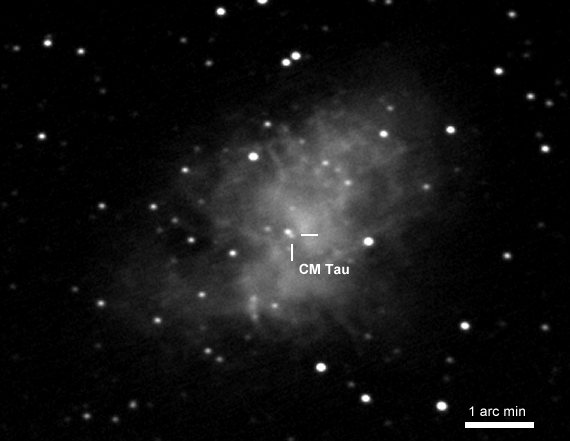David's Astronomy Pages (Projects)
Rotating Variable
Stars
Pulsating
Variables
Variable
Stars
Home
Page
Cataclysmic
Variables
David's Astronomy Pages (Projects)
|
Pulsating Variables |
Variable Stars |
Home Page |
Cataclysmic Variables |
Rotating Variable Stars Example/Project Stars ACV Alpha2 Canum Venaticorum stars (Type ACV) ACVO Rapidly oscillating Alpha2 CVn stars (Type ACVO) BY BY Draconis-type stars (Type BY) ELL Rotating ellipsoidal variables (Type ELL) FKCOM FK Comae Berenices stars (Type FKCOM) PSR Optically variable pulsars (Type PSR) | CM Tau | SXARI SX Arietis-type variables (Type SXARI)
Variable stars with nonuniform surface brightness and/or ellipsoidal shapes, whose variability is caused by axial rotation with respect to the observer. The nonuniformity of surface brightness distributions may be caused by the presence of spots or by some thermal or chemical inhomogeneity of the atmosphere caused by a magnetic field whose axis is not coincident with the rotation axis. These stars are subdivided into several types.
Alpha2 Canum Venaticorum variables. These are main-sequence stars with spectral types B8p-A7p and displaying strong magnetic fields. Their spectra show abnormally strong lines of Si, Sr, Cr, and rare earths whose intensities vary with rotation. They exhibit magnetic field and brightness changes (periods of 0.5-160 days or more). The amplitudes of the brightness changes are usually within 0.01-0.1 mag in V.
Rapidly oscillating Alpha2 Canum Venaticorom stars. These are non-radially pulsating, rotating magnetic variables of Ap spectral type. Pulsation periods are in the range of 6-12 min (0.004-0.01 days), while amplitudes of light variation caused by the pulsation are about 0.01 mag in V. The pulsational variations are superposed on those caused by rotation. Example: DO Eri
BY Draconis-type variables, which are dwarf stars of spectral type dKe-dMe showing quasiperiodic light changes with periods from a fraction of a day to 120 days and amplitudes from several hundredths to 0.5 mag in V. The light variability is caused by axial rotation of a star with a variable degree of nonuniformity of the surface brightness (spots), changing with time, and chromospheric activity. Some of these stars also show flares similar to those of UV Cet stars, and in those cases they also belong to the latter type and are simultaneously considered eruptive variables. Examples: our Sun, BY Dra (BY+UV)
Rotating ellipsoidal variables (b Per, Alpha Vir). These are close binary systems with ellipsoidal components, which change combined apparent brightness with periods equal to those of orbital motion because of changes in emitting areas seen by the observer, but showing no eclipses. Light amplitudes do not exceed 0.1 mag in V. Examples: b Per Alpha Vir.
FK Comae Berenices-type variables. These are rapidly rotating giants with non-uniform surface brightness, which have G-K spectral types with broad H and K Ca II emission and sometimes Halpha. They may also be spectroscopic binary systems. Periods of light variation (up to several days) are equal to rotational periods, and amplitudes are several tenths of a magnitude. These objects may be the product of further evolution of W UMa systems (Type EW). Examples: FK Com
Optically variable pulsars. These are rapidly rotating neutron stars with strong magnetic fields, radiating in the radio, optical, and X-ray regions. Pulsars emit narrow beams of radiation, and periods of their light changes coincide with rotational periods (from 0.004 to 4 s), while amplitudes of the light pulses reach 0.8 mag. Examples: CM Tau (remnant of supernova of 1054).
| M1 showing CM Tau - the pulsar at heart of Crab Nebula CM Tau is the remnant of the supernova of 1054 |

|
| Annotated CCD Image (150% size, cropped) Richardson-Lucy sharpened Image details as above [ Interenet picture of Pulsar CM Tau on web at http://www.scioly.org/eventpages/ ] |
Back to Top
Close binary systems characterized by the presence of strong reflection (re-radiation) of the light of the hot star illuminating the surface of the cooler companion. Light curves are sinusoidal with the period equal to Porb, maximum brightness coinciding with the passage of the hot star in front of the companion. The eclipse may be absent. The range of light variation is about 0.5-1.0mag V (KV Vel).
Back to Top
SX Arietis stars, sometimes called helium variables. These are main-sequence B0p-B9p stars with variable-intensity He I and Si III lines and magnetic fields. . Periods of light and magnetic field changes (about 1 day) coincide with rotational periods, while amplitudes are approximately 0.1 mag in V. These stars are high-temperature analogs of the ACV variables. Example: SX Ari
Back to Top
| This Web Page: | Rotating Variable Stars |
| Last Updated : | 2015-05-15 |
| Site Owner : | David Richards |
| Home Page : | David's Astronomy Web Site |